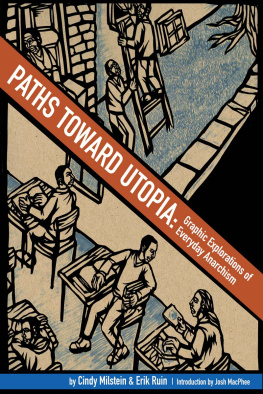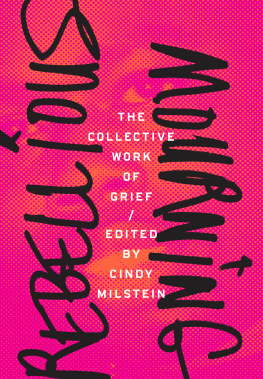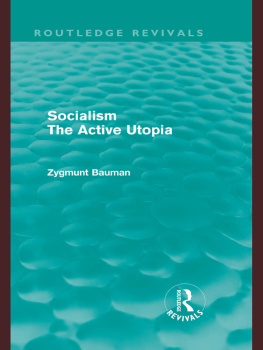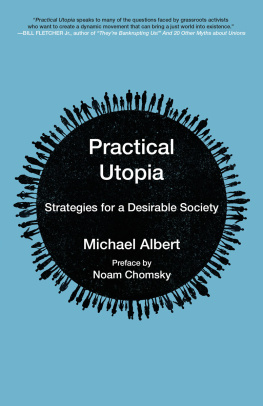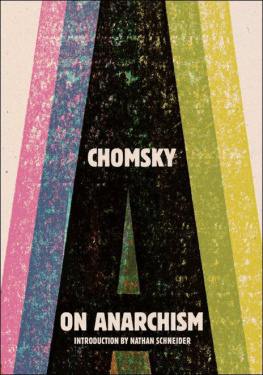
Paths toward Utopia: Graphic Explorations of Everyday Anarchism
Cindy Milstein and Erik Ruin
2012 PM Press
All rights reserved. No part of this book may be transmitted by any means without permission in writing from the publisher.
ISBN: 978-1-60486-502-8
Library of Congress Control Number: 2011917550
Cover design by Erik Ruin & Josh MacPhee
Interior design by Josh MacPhee/Antumbra Design
10 9 8 7 6 5 4 3 2 1
PM Press
PO Box 23912
Oakland, CA 94623
www.pmpress.org
Printed on recycled paper by the Employee Owners of Thomson-Shore in Dexter, Michigan. www.thomsonshore.com
CONTENTS
ACKNOWLEDGMENTS
Despite Paths toward Utopia being a collaborative effort between the two of us, we couldnt have done this book on our own. Were grateful to PM Pressnamely, Craig OHara, Gregory Nipper, and Ramsey Kanaanfor taking this project and us seriously when there wasnt much proof that our fragmentary idea would coalesce into an embodied whole, and laboring hard to get it into print. Appreciation as well to all those who lent us their eloquent words in the form of blurbs, and before that, World War 3 Illustrated for publishing our first two picture-essays.
Crucially, Josh MacPhee has been one of our strongest advocates and most insightful criticsboth invaluable gifts. He has also gifted us his words and design.
Last but not least, heaps and heaps of debt, of a thoroughly noncapitalist kind, to all the aspirations, flights of fancy, and working existences of the recent do-it-ourselves commons and movements from belowpeopled by dreamers, agitators, occupiers, troublemakers and gender-troublers, critical thinkers, pirates, anarchists and autonomists, queers, rabble-rousers and rebels, and so many other misfits who havent given up on themselves and each other, and are willing to be visionary vagabonds on this journey together.
Cindy My greatest acknowledgment for this book is to Erik, as longtime dear friend and inspiration, as fellow heretic and, I trust, ongoing coconspirator. Josh MacPhee has stood by my side throughout, as another longtime dear friend and inspiration. If Erik and Josh both make me feel loved and at home in this inhospitable world, so too, always, does Joshua Stephens, and he yet again came to my mutual aid, training his keen mind and editorial eye on my prologue. Love also to utopias found during the development of these picture-essaysmost poignantly, my Station 40 chosen family in San Francisco and my occupy neighborhood in Philly.
Erik My deepest gratitude, of course, goes out to Cindy for going down this long road together with me, for struggling together to make the best that we could make, and for her patience and support. Thanks as well to my dear friend and constant inspiration Josh MacPhee along with the rest of my comrades in the Justseeds Artists Cooperative. Nidal El-Khairy deserves kudos for his crucial assistance with Arabic-language slogans and signage in Waking to Revolution. Id also like to acknowledge Emmy Bright, Joshua Marcus, and Meredith Younger for feedback and advice at various stages.
FOREWORD Josh MacPhee
I hope the book you are reading is a turning point, a dawn in graphic politics. A writer and an artist have met in the space between their disciplines, and created something new. It is not a graphic novel in the traditional sense. Each chapter is more a poetic essay than a story driven by characters and narrative. It is not a series of illustrated essays either, for far too often the images drive the page, dismissing such a simple description of this work. What we have here is simultaneously a theoretical and graphic engagement with some of the most important ideas circulating in, and struggles facing, the world today.
At their best, Ruins bold yet complex graphics lift Milsteins words, and together they successfully recast everyday political engagement as vital resistance and prefigurative transformation. His graphic renditions of Milsteins actual text always remind us that we write our own stories. The words emerge from mouths, shout from banners; they exist as graffiti on walls and words on homemade signage. Otherwise-dense theoretical frameworks become our words, thoughts, and conversations. In the integrated textual-image world Milstein and Ruin conjure, we glimpse a place where there is no longer a separation between thought and action, subject and object. We live our words. They are the walls we run into and the roads we walk along.
This is further captured by the compactness of word and image. These are not long essays we need to slog through. They are short and pithy, and read practically as action poems. Yet a cascade of ideas also flows within each one. It is the same with the imagery. A quick scan gives us the basic gist, but the overlays and reworkings invite us to dig deeper, to see exchanges and glances not held within the text alone.
The two-page chapter Food for Thought acts as a central pillar of the book. It solidly frames the different aspects of our survival under capitalism as both our doing and undoing. In Ruins illustration, these acts and aspirations flood out of our mouths, turning our faces into both megaphones and broken fountains. Some of these (speech) acts buoy and nourish us. They are the water we drink, wash, and frolic in. But others we lose control over; they threaten to submerge us. This is the duality of our lives, illustrating the ways in which our survival techniques sustain us, yet paradoxically satiate the things we oppose. It is all water, and the struggle is how to drink without drowning.
The chapter Solidarity Is a Pizza brings out the subtleties of this dialecticthe ways that it works on us that we might not recognize. We are introduced to powerful and emotional examples of international solidarity, how simple gestures like an Egyptian worker ordering a pizza for occupiers in Madison, Wisconsin, become overwhelming symbols of the fragility of the borders that keep us apart. At the same time, in the final double-page spread, the crumbled border converts the basic equation of solidarity equals liberation into something more illusive. The wall has come down, but other boundaries remain. The two people sitting at the table across the once-existing border seem no closer, nor happier, than before. There are miles and decades of barriers, many invisible, between them that still need to be broken down. Here, graphic and textual representation work with and against each other, creating a richer fabric than either would do alone.
Paths toward Utopia continuously brings us back to the concept of the commons. The need for a commons, what we share among us with no claim to private ownership, is an idea so simple and powerful, yet simultaneously so elusive in the face of capitalisms ability to shape our perceptions of reality. The commons are often left hanging in the theoretical ether, seemingly just out of reach. By grounding them in our quotidian existence, our experience with public libraries (Borrowing from the Library), parks (Picking Up the Park), and gift giving (The Gift)activities that all readers will recognizethe commons become living things. We draw from and give to them; they nourish our actual lived lives, not merely the way we think about those lives. At the same time, while I revel in the commonsenseness of these examples, part of me cant help but want to see the other sides too: the complications, poison gifts, and libraries that enclose rather than liberate knowledge. Im not sure we can effectively build and protect our commons if we dont acknowledge their weaknesses and failings.
Next page
